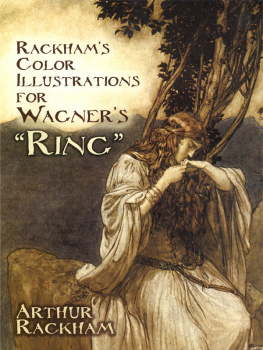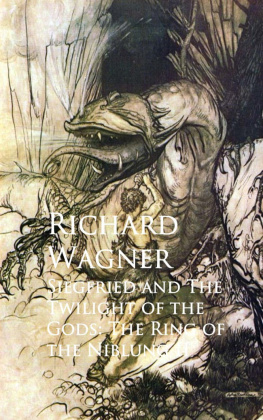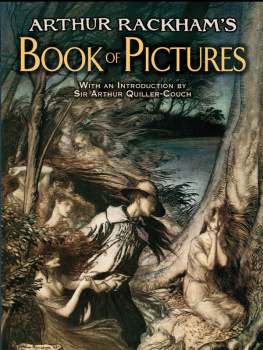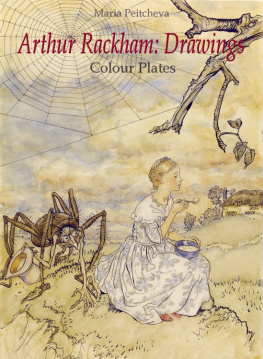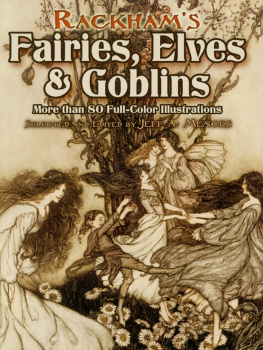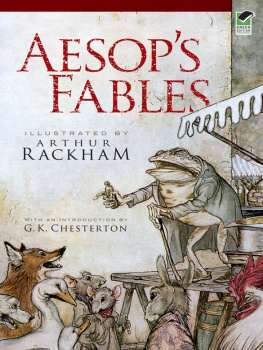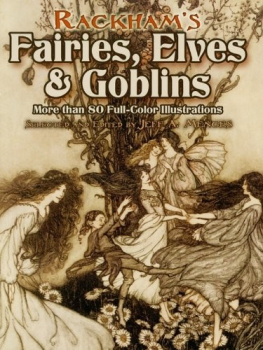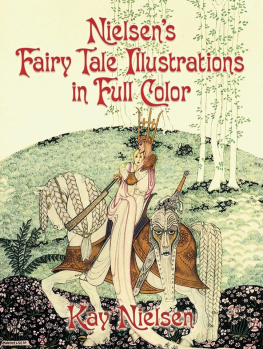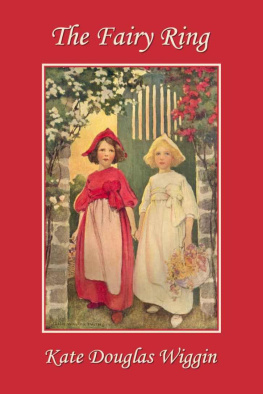Copyright
Copyright 1979 by Dover Publications, Inc.
All rights reserved.
Rackhams Color Illustrations for Wagners Ring is a new work, first published in 1979. The color illustrations, here reproduced in their entirety, and the black-and-white vignettes and tailpieces, here reproduced in a selection, appeared in two volumes, both published by William Heinemann, London, and Doubleday, Page & Co., New York: Siegfried & the Twilight of the Gods (1911) and The Rhinegold & The Valkyrie (1912). The introduction and captions have been written by James Spero.
International Standard Book Number
ISBN-13: 978-0-486-23779-4
ISBN-10: 0-486-23779-6
Library of Congress Catalog Card Number: 78-73985
Manufactured in the United States by Courier Corporation
23779611
www.doverpublications.com

RACKHAMS COLOR ILLUSTRATIONS FOR WAGNERS RING
ARTHUR RACKHAM
TEXT BY
JAMES SPERO

DOVER PUBLICATIONS, INC.
MINEOLA, NEW YORK
INTRODUCTION

According to a romantic tradition, the family into which Arthur Rackham was born in London on September 19, 1867 was descended from John Rackham, who had been hanged as a pirate in 1720. Be this as it may, Arthurs immediate family was conventionally and respectably middle class, his father having worked his way up in the civil service to the post of Admiralty Marshall.
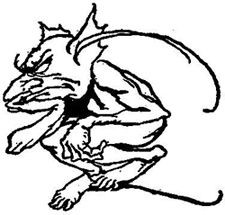
Young Arthurs passion for art was such that, made to retire early, he would smuggle a pencil and paper into bed with him to continue his sketching. During his childhood he was greatly impressed by Arthur Boyd Houghtons illustrations for The Arabian Nights in the Dalziel edition of 1865. It is also safe to assume that he was exposed to the fantastic creations of Richard Doyle. In 1879 he was admitted to the City of London School, Cheapside, where he won a prize for drawing.
In 1884 Rackham was sent to Australia in the hope that the bracing sea air would improve his delicate health. Returning to London that autumn, he enrolled in the Lambeth School of Art, where fellow students included Charles Ricketts, Thomas Sturge Moore and Leonard Raven-Hill. For all his creative imagination, Rackham was levelheaded. Entering the world of business as a statistician in an insurance company, he continued his practice of art at night, submitting work to the many illustrated weeklies that were published at the time. His first published drawing appeared in 1884 in Scraps. By 1893, Rackham had established enough of a reputation that he was invited to join the staff of the newly formed Westminster Budget.
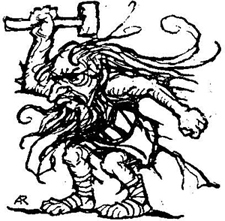
Now working as a full-fledged graphic journalist, Rackham was called upon to illustrate themes ranging from royal events and robberies to theatrical presentations. While he was starting out on this career, the method of printing illustrations was undergoing a revolution. Previously, an artists drawing had to be copied onto a block of wood by an engraver, who would frequently alter the original to meet the limitations of either the medium or his ability. Now, by means of the photo-zinc process, line drawings could be reproduced directly, eliminating this artistic middleman. Also, the halftone method of reproducing artwork with gradations of tone had been developed. These innovations greatly widened the technical resources of graphic journalists, but at the same time they spelled their doom, for photographs could now be reproduced in publications, rendering these artists superfluous.
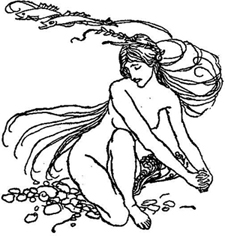
But Rackham was already veering away from graphic journalism toward illustration of stories and books. His first book had appeared in 1893: To the Other Side, published as a travel brochure for the Norddeutsch Lloyd Company. The next year he executed four illustrations for Anthony Hopes The Dolly Dialogues. With work published in periodicals such as Little Folks (to which he began contributing in 1896), Rackham was moving toward his true calling. The world of illustration was bustling in the 1890s, and Rackham must have been influenced by the work of contemporary artists such as Howard Pyle, J. F. Sullivan, Charles Robinson, Archie MacGregor and Alice B. Woodward. Aubrey Beardsley, too, was at the height of his meteoric career, and Rackham fell under his spell although he did radically adapt Beardsleys style to meet his own purposes.
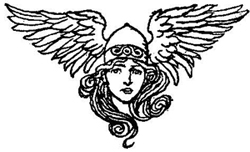
It was in 1900, with Rackhams edition of Grimms Fairy Tales (95 black-and-white illustrations with a colored frontispiece), that the artist first achieved recognition. (These illustrations were later redone, many as watercolors, for the edition of 1909.) In 1905 his reputation was firmly established with the publication of Rip van Winkle. His 51 watercolor illustrations to Washington Irvings classic possess all the well-known Rackham hallmarks: the unique interpretation of otherworldly beings, the appealing portrayal of children, a deep feeling for landscape and plantlife (especially for gnarled trees), and an ironclad technique highlighted by a deft line and the delicate application of washes of subdued color. The book was published by William Heinemann, establishing a relationship which, although not exclusive, lasted for many years. A pattern of publication soon emerged. First a limited edition was issued, followed by a trade edition, the American edition (published by Doubleday, Page & Co.) and a French edition. All are now eagerly sought by collectors.
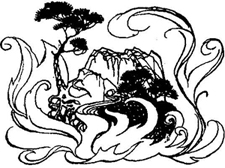
This success was quickly followed by another. Peter Pan in Kensington Gardens (1906) was rapturously received by the public as well as by the author, James Barrie. Rackhams illustrations for Alices Adventures in Wonderland (1907) ran up against the prejudice the public has always held against any artist attempting an interpretation differing from that of John Tenniel, illustrator of the original. In 1908 Rackhams illustrations to Shakespeares A Midsummer-Nights Dream appeared. They are thought by many to be his masterpiece, although his treatment of Undine (1909) is in no way inferior. By 1910 Rackham had become the leading illustrator of the period, not only making an excellent living from the royalties from his books, but also getting good prices for the sale of the original watercolors after exhibition in London galleries. In 1920, his peak year, his income soared to 7000.
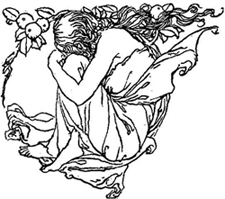
In 1909, Rackham set about illustrating Richard Wagners operatic tetralogy Der Ring des Nibelungen (The Nibelungs Ring), which consists of a prologue (Das Rheingold) followed by three days Die Walkre (The Valkyrie), Siegfried and Die Gtterddmmerung (The Twilight of the Gods). In these illustrations Rackham saw the opportunity to create something on a grander, more prestigious plane than in his former work; since the first performances of the Ring in August 1876, the world had attached unusual importance to the cycle. For the premiere performances luminaries had flocked to the sleepy Bavarian town of Bayreuth, where Wagner had built his Festspielhaus expressly for presentation of the cycle. The works rocked musical Europe, as had every Wagnerian opera since Der fliegende Hollnder. Wagner died in 1883, but by the turn of the century the prestige of his operas had grown to the point where they held a status that was almost religious. After the Second World War they were placed in a more realistic perspective, but it is important to remember the significance they held in Rackhams time.
Next page
